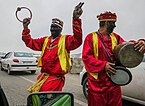Nowruz
| Nowruz | |
|---|---|
Haft-sinin Iran Azerbaijani man and woman in traditional Nowruz outfits Kurdish girl inPalangan,Iran, during Nowruz festival preparations Kazakh students in traditional Nowruz outfits during a musical performance Citizens from theCommonwealth of Independent Statesdancing inMoscow,Russia, for Nowruz festivities | |
| Observed by | Iranian peoples(originally) Current countries:
|
| Type | Cultural |
| Significance | Vernal equinox;first day of a new year on theSolar Hijri calendar |
| Date | Between 19 and 22 March[25] |
| 2024 date | 03:06:26, 20 March (UTC)[26][27] |
| Frequency | Annual |
| Nawrouz, Novruz, Nowrouz, Nowrouz, Nawrouz, Nauryz, Nooruz, Nowruz, Navruz, Nevruz, Nowruz, Navruz | |
|---|---|
| Country | Afghanistan, Azerbaijan, India, Iran, Iraq, Kazakhstan, Kyrgyzstan, Pakistan, Tajikistan, Turkey, Turkmenistan, and Uzbekistan |
| Reference | 1161 |
| Region | Asia and the Pacific |
| Inscription history | |
| Inscription | 2016 (4th session) |
NowruzorNavroz(Persian:نوروز[noːˈɾuːz])[t]is theIranian New YearorPersian New Year.[28][29]Historically, it has been observed byPersiansand otherIranian peoples,[30]but is now celebrated by many ethnicities worldwide. It is a festival based on theNorthern Hemisphere spring equinox,[31]which marks the first day of a new year on theSolar Hijri calendar;it usually coincides with a date between 19 March and 22 March on theGregorian calendar.
The roots of Nowruz lie inZoroastrianism,and it has been celebrated by many peoples acrossWest Asia,Central Asia,theCaucasusand theBlack Sea Basin,theBalkans,andSouth Asiafor over 3,000 years.[32][33][34][35]In the modern era, while it is observed as a secular holiday by most celebrants, Nowruz remains a holy day for Zoroastrians,[36]Baháʼís,[37]andIsmaʿili Shia Muslims.[38][39][40]
For theNorthern Hemisphere,Nowruz marks the beginning ofspring.[27][41]Customs for the festival include various fire and water rituals, celebratory dances, gift exchanges, and poetry recitations, among others; these observances differ between the cultures of the diverse communities that celebrate it.[42]
Overview
The first day of theIranian calendarfalls on theMarch equinox,the first day of spring, around 21 March. In the 11th century AD the Iranian calendar was reformed byOmar Khayyamin order to fix the beginning of the calendar year, i.e. Nowruz, at the vernal equinox. Accordingly, the definition of Nowruz given by the Iranian astronomerTusiwas the following: "the first day of the official New Year [Nowruz] was always the day on which the sun enteredAriesbefore noon. "[43]Nowruz is the first day ofFarvardin,the first month of theIranian solar calendar,which is the official calendar in use inIran,and formerly inAfghanistan.
TheUnited Nationsofficially recognized the "International Day of Nowruz" with the adoption of Resolution 64/253 by theUnited Nations General Assemblyin February 2010.[44][45]
Etymology
The wordNowruzis a combination of the Persian wordsنو(now,meaning 'new') andروز(ruz,'day'). Pronunciation varies among Persian dialects, with Eastern dialects using the pronunciation[nawˈɾoːz](as in Dari and Classical Persian, however in Tajik, it isnavrūz,writtenнаврӯз), western dialects[nowˈɾuːz],andTehranis[noːˈɾuːz].A variety of spelling variations for the wordnowruzexist in English-language usage, includingnorooz,novruz,nowruz,navruz,nauruzandnewroz.[46][47]
Spring equinox calculation

Nowruz's timing is based on thevernal equinox.In Iran, it is the day of the new year in theSolar Hijri algorithmic calendar,which is based on precise astronomical observations, and moreover use of sophisticated intercalation system, which makes it more accurate than its European counterpart, theGregorian calendar.[48]
Each 2820-year great grand cycle contains 2,137 normal years of 365 days and 683 leap years of 366 days, with the average year length over the great grand cycle 365.24219852. This average is just 0.00000026 (2.6×10−7) of a day—slightly more than 1/50 of a second—shorter thanNewcomb's value for the meantropical yearof 365.24219878 days, but differs considerably more from the current average vernal equinox year of 365.242362 days, which means that the new year, intended to fall on the vernal equinox, would drift by half a day over the course of a cycle.[48]As the source explains, the 2820-year cycle is erroneous and has never been used in practice.
Chaharshanbe Suri
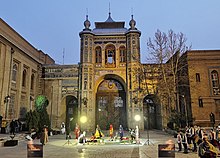
Chaharshanbe Suri (Persian:چهارشنبهسوری,romanized:čahâr-šanbeh suri(lit. "Festive Wednesday" ) is a prelude to theNew Year.[citation needed]In Iran, it is celebrated on the eve of the last Wednesday before Nowruz. It is usually celebrated in the evening by performing rituals such as jumping overbonfiresand lighting offfirecrackersandfireworks.[49][50]
In Azerbaijan, where the preparation for Novruz usually begins a month earlier, the festival is held every Tuesday during four weeks before the holiday of Novruz. Each Tuesday, people celebrate the day of one of the four elements—water, fire, earth and wind.[51]On the holiday eve, the graves of relatives are visited and tended.[52][53]
Iranians sing the poetic line "my yellow is yours, your red is mine", which means "my weakness to you and your strength to me" (Persian:سرخی تو از من، زردی من از تو,romanized:sorkhi-ye to az man, zardi-ye man az to) to the fire during the festival, asking the fire to take away ill-health and problems and replace them with warmth, health, and energy.Trail mixandberriesare also served during the celebration.
Spoon banging (قاشق زنی,qāšoq zani) is a tradition observed on the eve of Charshanbe Suri, similar to theHalloweencustom oftrick-or-treating.In Iran, people weardisguisesand go door-to-door banging spoons against plates or bowls and receive packaged snacks. In Azerbaijan, children slip around to their neighbors' homes and apartments on the last Tuesday prior to Novruz, knock at the doors, and leave their caps or little basket on the thresholds, hiding nearby to wait for candies, pastries and nuts.[51]
The ritual of jumping over fire has continued in Armenia in the feast ofTrndez,which is a feast of purification in theArmenian Apostolic Churchand theArmenian Catholic Church,celebrated forty days afterJesus's birth.[54]
Sizdah Be-dar
In Iran, the Nowruz holidays last thirteen days. On the thirteenth day of the New Year, Iranians leave their houses to enjoy nature andpicnicoutdoors, as part of the Sizdah Bedar ceremony. The greenery grown for theHaft-sinsetting is thrown away, usually into running water. It is also customary for young single people, especially young girls, to tie the leaves of the greenery before discarding it, expressing a wish to find a partner. Another custom associated with Sizdah Bedar is the playing of jokes and pranks, similar toApril Fools' Day.[55]
History
Origin in the Iranian religions
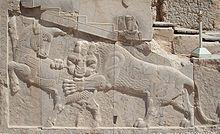
There exist various foundation myths for Nowruz inIranian mythology.
TheShahnamehcredits the foundation of Nowruz to the mythical Iranian KingJamshid,who saves mankind from a winter destined to kill every living creature.[56]To defeat the killer winter, Jamshid constructed a throne studded with gems. He had demons raise him above the earth into the heavens; there he sat, shining like the Sun. The world's creatures gathered and scattered jewels around him and proclaimed that this was theNew Day(Now Ruz). This was the first day ofFarvardin,which is the first month of theIranian calendar.[57]
Although it is not clear whether Proto-Indo-Iranians celebrated a feast as the first day of the calendar, there are indications that Iranians may have observed the beginning of both autumn and spring, respectively related to the harvest and the sowing of seeds, for the celebration of the New Year.[58]Mary Boyceand Frantz Grenet explain the traditions for seasonal festivals and comment: "It is possible that the splendor of theBabylonianfestivities at this season, led the Iranians to develop their own spring festival into an established New Year feast, with the nameNavasarda"New Year" (a name which, though first attested through Middle Persian derivatives, is attributed to the Achaemenian period). "Akituwas the Babylonian festivity held during the spring month ofNisanin which Nowruz falls. Since the communal observations of the ancient Iranians appear in general to have been seasonal ones and related to agriculture, "it is probable that they traditionally held festivals in both autumn and spring, to mark the major turning points of the natural year."[58]
Nowruz is partly rooted in the tradition ofIranian religions,such asMithraismandZoroastrianism.In Mithraism, festivals had a deep linkage with the Sun's light. The Iranian festivals such asMehregan(autumnal equinox),Tirgan,and the eve ofChelle ye Zemestan(winter solstice) also had an origin in the Sun god (Mithra). Among other ideas, Zoroastrianism is the firstmonotheisticreligion that emphasizes broad concepts such as the corresponding work of good and evil in the world, and the connection of humans to nature. Zoroastrian practices were dominant for much of the history of ancient Iran. In Zoroastrianism, the seven most important Zoroastrian festivals are the sixGahambarfestivals and Nowruz, which occurs at thespring equinox.According toMary Boyce,[59]"It seems a reasonable surmise that Nowruz, the holiest of them all, with deep doctrinal significance, was founded byZoroasterhimself "; although there is no clear date of origin.[60]Between sunset on the day of the sixth Gahambar and sunrise of Nowruz,Hamaspathmaedaya(later known, in its extended form, asFrawardinegan;and today is known asFarvardigan) was celebrated. This and the Gahambars are the only festivals named in the surviving text of theAvesta.
The 10th-century scholarBiruni,in his workKitab al-Tafhim li Awa'il Sina'at al-Tanjim,provides a description of the calendars of various nations. Besides the Iranian calendar, various festivals of Greeks, Jews, Arabs, Sabians, and other nations are mentioned in the book. In the section on the Iranian calendar, he mentions Nowruz,Sadeh,Tirgan, Mehrgan, the six Gahambars, Farvardigan, Bahmanja,Esfand Armazand several other festivals. According to him, "It is the belief of the Iranians that Nowruz marks the first day when the universe started its motion."[61]The Persian historianGardizi,in his work titledZayn al-Akhbār,under the section of the Zoroastrians festivals, mentions Nowruz (among other festivals) and specifically points out thatZoroasterhighly emphasized the celebration of Nowruz and Mehrgan.[62][63]
Achaemenid period

Although the wordNowruzis not recorded inAchaemenidinscriptions,[64]there is a detailed account byXenophonof a Nowruz celebration taking place in Persepolis and the continuity of this festival in the Achaemenid tradition.[65]Nowruz was an important day during the Achaemenid Empire (c. 550–330 BC). Kings of the different Achaemenid nations would bring gifts to theKing of Kings.The significance of the ceremony was such that KingCambyses II's appointment as the king ofBabylonwas legitimized only after his participation in the referred annual Achaemenid festival.[66]
Celebrations at Persepolis
It has been suggested that the famousPersepoliscomplex, or at least the palace ofApadanaand the Hundred Columns Hall, were built for the specific purpose of celebrating a feast related to Nowruz.
Iranian and Jewish calendars
In 539 BC, the Jews came under Iranian rule, thus exposing both groups to each other's customs. According to theEncyclopædia Britannica,the story ofPurimas told in theBook of Estheris adapted from an Iranian novella about the shrewdness of harem queens, suggesting that Purim may be an adoption of Iranian New Year.[67]A specific novella is not identified and Encyclopedia Britannica itself notes that "no Jewish texts of this genre from the Persian period are extant, so these new elements can be recognized only inferentially." Purim is celebrated the 14 ofAdar,usually within a month before Nowruz (as the date of Purim is set according to theJewish calendar,which islunisolar), while Nowruz occurs at the spring equinox. It is possible that the Jews and Iranians of the time may have shared or adopted similar customs for these holidays.[68]TheLunar new year of the Middle Eastoccurs on 1Nisan,thenew moonof the first month of spring, which usually falls within a few weeks of Nowruz.
Legacy in Persian literature
In hisShahnameh,the tenth-century poetFerdowsinarrates a fictional account ofDarius III's death, where an injured Darius, with his head cradled onAlexander the Great’s thigh, asks Alexander to wedRoxana,so their children might uphold Nowruz and keep the flame of Zoroaster burning:
Her mother named her Roxana the fair; The world found joy and solace in her care.... From her, perhaps, a glorious one shall rise; Who shall renew the name of boldEsfandiyār,wise. This sacred flame of Zoroaster, he shall adorn; TheZendandAvestascriptures, in his hands be borne. The feast ofSadeh,this auspicious rite he'll keep; The splendor ofNowruzandfire templesdeep.[69]
— Ferdowsi
Parthian and Sasanian periods
Nowruz was the holiday ofParthiandynastic empires who ruled Iran (248 BC–224 AD) and the other areas ruled by the Arsacid dynasties outside ofParthia(such as the Arsacid dynasties ofArmeniaandIberia). There are specific references to the celebration of Nowruz during the reign ofVologases I(51–78 AD), but these include no details.[64]BeforeSassaniansestablished their power in Western Asia around 300 AD, Parthians celebrated Nowruz in autumn, and the first ofFarvardinbegan at the autumn equinox. During the reign of the Parthian dynasty, the spring festival wasMehregan,aZoroastrianand Iranian festival celebrated in honor ofMithra.[70]
Extensive records on the celebration of Nowruz appear following the accession ofArdashir I,the founder of theSasanian Empire(224–651 AD). Under the Sassanid emperors, Nowruz was celebrated as the most important day of the year. Most royal traditions of Nowruz, such as royal audiences with the public, cash gifts, and the pardoning of prisoners, were established during the Sassanid era and persisted unchanged until modern times.
Arab conquest and Islamization of Persia
Nowruz, along with the mid-winter celebrationSadeh,survived theMuslim conquest of Persiaof 650 CE. Other celebrations such as theGahambarsandMehrganwere eventually side-lined or only observed byZoroastrians.Nowruz became the main royal holiday during theAbbasidperiod. Much like their predecessors in the Sasanian period,Dehqanswould offer gifts to the caliphs and local rulers at the Nowruz and Mehragan festivals.[71]
Following the demise of the caliphate and the subsequent re-emergence of Iranian dynasties such as theSamanidsandBuyids,Nowruz became an even more important event. The Buyids revived the ancient traditions of Sassanian times and restored many smaller celebrations that had been eliminated by the caliphate. The IranianBuyidruler'Adud al-Dawla(r. 949–983) customarily welcomed Nowruz in a majestic hall, decked with gold and silver plates and vases full of fruit and colorful flowers.[72]The King would sit on the royal throne, and the court astronomer would come forward, kiss the ground, and congratulate him on the arrival of the New Year.[72]The king would then summon musicians and singers, and invited his friends to gather and enjoy a great festive occasion.[72]
LaterTurkicandMongolinvaders did not attempt to abolish Nowruz.
In 1079 CE during theSeljuq dynastyera, a group of eight scholars led by astronomer and polymathOmar Khayyamcalculated and established theJalali calendar,computing the year starting from Nowruz.
The festival along with Mehregan was widely celebrated inAl-Andalus,as the Andalusians from the 9th century onwards strongly identified with many Iranian traditions despite the opposition from theMaliki jurists.Also, from the 10th century onwards the nobility, emirs and governors sponsored the celebrations and festivals. However, the jurists beginning from the 12th century started encouraging the Andalusians to celebrateMawlidinstead.[73]
Contemporary era
Before the collapse of theSoviet Union,Iran and Afghanistan were the only countries that officially observed the ceremonies of Nowruz. When theCaucasianandCentral Asiancountries gained independence from the Soviets, they also declared Nowruz as a national holiday.
Nowruz was added to theUNESCO List of the Intangible Cultural Heritage of Humanityin 2010.[74][75][76][77]
Customs
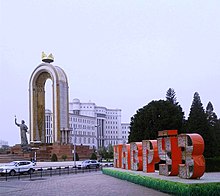
House cleaning and shopping
House cleaning, orshaking the house(Persian:خانه تکانی,romanized:xāne tekāni) is commonly done before the arrival of Nowruz. People start preparing for Nowruz with a majorspring cleaningof their homes and by buying new clothes to wear for the New Year, as well as the purchase of flowers. Thehyacinthand thetulipare popular and conspicuous.[78]
Visiting family and friends
During the Nowruz holidays, people are expected to make short visits to the homes of family, friends and neighbors. Typically, young people will visit their elders first, and the elders return their visit later. Visitors are offered tea and pastries, cookies, fresh and dried fruits and mixed nuts or other snacks. Many Iranians throw large Nowruz parties as a way of dealing with the long distances between groups of friends and family.[79]
Food preparation
One of the most common foods cooked on the occasion of Nowruz isSamanu(Samanak, Somank, Somalek). This food is prepared using wheat germ. In most countries that celebrate Nowruz, this food is cooked. In some countries, cooking this food is associated with certain rituals. Women and girls in different parts of Iran, Afghanistan, Tajikistan, Turkmenistan and Uzbekistan cook Samanu in groups and sometimes during the night, and when cooking it, they sing memorable songs.
Cooking other foods is also common on Nowruz. For example,sabzi polowith fish is eaten on Eid night, as are sweets such asNan-e Nokhodchi.In general, cooking Nowruz food is common in every region where Nowruz is celebrated, and each area has its food and sweets.
Haft-sin
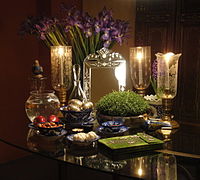
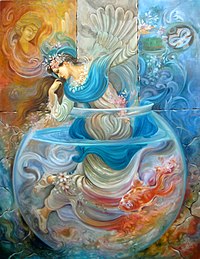
Typically, before the arrival of Nowruz, family members gather around the Haft-sin table and await the exact moment of theMarch equinoxto celebrate the New Year.[80][81]The number 7 and the letter S are related to the seven Ameshasepantas as mentioned in the Zend-Avesta. They relate to the four elements of Fire, Earth, Air, Water, and the three life forms of Humans, Animals and Plants. In modern times, the explanation was simplified to mean that the Haft-sin (Persian:هفتسین,seven things beginning with the letter sin (س)) are:
- Sabze (Persian:سبزه) –wheat,barley,mung bean,orlentilsprouts grown in a dish.
- Samanu(Persian:سمنو) – sweetpuddingmade fromwheat germ
- Persian olive (Persian:سنجد,romanized:senjed)
- Vinegar(Persian:سرکه,romanized:serke)
- Apple (Persian:سیب,romanized:sib)
- Garlic (Persian:سیر,romanized:sir)
- Sumac(Persian:سماق,romanized:somāq)
The Haft-sin table may also include a mirror, candles,painted eggs,a bowl of water,goldfish,coins,hyacinth,and traditional confectioneries. A "book of wisdom" such as theQuran,Bible,Avesta,theŠāhnāmeofFerdowsi,orthe divānofHafezmay also be included.[80]Haft-sin's origins are not clear. The practice is believed to have been popularized over the past 100 years.[82]
Haft-mewa
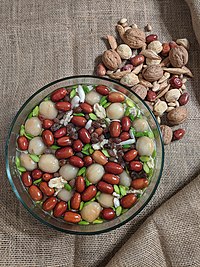
In Afghanistan, people prepare Haft Mēwa (Dari:هفت میوه,English:seven fruits) for Nauruz, a mixture of seven differentdried fruitsand nuts (such asraisins,silver berry,pistachios,hazelnuts,prunes,walnut,andalmonds) served in syrup.[83]
Khoncha

Khoncha (Azerbaijani:Xonça) is the traditional display of Novruz in the Republic of Azerbaijan. It consists of a big silver or copper tray, with a tray of green, sprouting wheat (samani) in the middle and a dyed egg for each member of the family arranged around it. The table should be with at least seven dishes.[51]
Amu NowruzandHajji Firuz
In Iran, the traditional heralds of the festival of Nowruz areAmu NowruzandHaji Firuz,who appear in the streets to celebrate the New Year.
Amu Nowruz brings children gifts, much like his counterpartSanta Claus.[84]He is the husband ofNane Sarma,with whom he shares a traditional love story in which they can meet each other only once a year.[85][86]He is depicted as an elderly silver-haired man with a long beard carrying a walking stick, wearing a felt hat, a long cloak of blue canvas, a sash,giveh,and linen trousers.[87]
Haji Firuz, a character with his face and hands covered in soot, clad in bright red clothes and a felt hat, is the companion of Amu Nowruz. He dances through the streets while singing and playing the tambourine. In the traditional songs, he introduces himself as a serf trying to cheer people whom he refers to as his lords.[88]
Kampirak
In the folklore of Afghanistan, Kampirak and his retinue pass village by village, distributing gathered charities among people. He is an old, bearded man wearing colorful clothes with a long hat and rosary who symbolizes beneficence and the power of nature yielding the forces of winter. The tradition is observed in central provinces, speciallyBamyanandDaykundi.[89]
Nauryz kozhe
In Kazakhstan, Kazakhs start the new year by cookingnauryz kozhe,a traditional drink.[90]
Communities
The festival of Nowruz is celebrated by many groups of people in theBlack Seabasin, theBalkans,theSouth Caucasus,Western Asia,centralandsouthernAsia, and byIranian peoplesworldwide.[91]

Places where Nowruz is a public holiday include:
- Afghanistan[92]
- Albania[1][2]
- Azerbaijan (five days)[93][94]
- Georgia[95]
- Iran (thirteen days)[96]
- Iraqi Kurdistan,Iraq[97]
- Kazakhstan (four days)[13]
- Kosovo[citation needed]
- Kyrgyzstan[98][99]
- Bayan-Ölgii,Mongolia[14]
- Tajikistan (four days)[21][100]
- Turkmenistan (two days)[101]
- Uzbekistan[102]
Nowruz is celebrated byKurdsinIraq[10][103]Syria,andTurkey,[104]as well as by theIranis,ShiasandParsisin theIndian subcontinentandIranian diaspora.
Nowruz is also celebrated by Iranian communities in the Americas and in Europe, includingLos Angeles,Phoenix,Toronto,CologneandLondon.[105]In Phoenix, Arizona, Nowruz is celebrated at the Persian New Year Festival.[106]But because Los Angeles is prone to devastating fires, there are very strict fire codes in the city. Usually, Iranians living in Southern California go to the beaches to celebrate the event where it is permissible to build fires.[107]On 15 March 2010, theUnited States House of Representativespassed theNowruz Resolution(H.Res. 267), by a 384–2 vote,[108]"Recognizing the cultural and historical significance of Nowruz".[109]
Afghanistan
Nowruz marks Afghanistan's New Year's Day with theSolar Hijri Calendaras their official calendar. In Afghanistan, the festival of Gul-i-Surkh (Dari:گل سرخ,'red flower') is the principal festival for Nauruz. It is celebrated inMazar-i-Sharifduring the first 40 days of the year, when red tulips grow in the green plains and over the hills surrounding the city. People from all over the country travel to Mazar-i-Sharif to attend the Nauruz festivals.Buzkashitournaments are held during the Gul-i-Surkh festival in Mazar-i-Sharif,Kabuland other northern Afghan cities.
Jahenda Bala(Dari:جهنده بالا,'raising') is celebrated on the first day of the New Year.[110]It is a religious ceremony performed at theBlue Mosqueof Mazar-i-Sharif by raising a special banner resembling theDerafsh Kavianiroyal standard. It is attended by high-ranking government officials such as the Vice-President, Ministers, and Provincial Governors and is the biggest recorded Nawroz gathering, with up to 200,000 people from all over Afghanistan attending.
In the festival ofDehqān(Dari:دهقان,'farmer'), also celebrated on the first day of the New Year, farmers walk in the cities as a sign of encouragement for the agricultural production. In recent years, this activity only happens in Kabul and other major cities where the mayor and other government officials attend.
During the first two weeks of the New Year, the citizens ofKabulhold family picnics inIstalif,Charikarand other green places whereredbudsgrow.
During theTaliban regime of 1996–2001,Nauruz was banned as "an ancient pagan holiday centered on fire worship".[111]In March 2022, the Taliban said that Nauruz would not be a public holiday that year, although allowed celebrations to take place.[112]
Albania
Nevruz is celebrated annually in Albania on 22 March as Sultan Nevruz. In Albania, the festival commemorates the birthday ofAli ibn Abi Talib(died 661 CE) and simultaneously the advent of spring. It is prominent amongst the nations'Bektashis,but adherents of Sunnism, Catholicism, and Orthodoxy also "share in the nevruz festival to respect the ecumenical spirit of Albania".
Armenia
Since the 19th century, Nowruz has not generally been celebrated byArmeniansand is not a public holiday inArmenia.However, it is celebrated in Armenia by tens of thousands of Iranian tourists who visit Armenia with relative ease.[113]The influx of tourists from Iran accelerated since around 2010–11.[114][115]In 2010 alone, around 27,600 Iranians spent Nowruz in capitalYerevan.[116]
In 2015, PresidentSerzh Sargsyansent a letter of congratulations toKurds living in Armeniaand to the Iranian political leadership on the occasion of Nowruz.[117]
Azerbaijan
In Azerbaijan, Nowruz celebrations go on for several days and included festive public dancing and folk music, and sporting competitions. In rural areas, crop holidays are also marked.[118]Additionally, in Azerbaijani tradition, the weather on the first day of Novruz is believed to forecast the seasons: spring, summer follows on the second day, autumn on the third, and winter on the fourth.[119][120]
Communities of the Azerbaijani diaspora also celebrate Nowruz in the US, Canada,[121]and Israel.[122]
Bangladesh
Nowruz is generally not celebrated by Bangladeshis, but it is widely celebrated by the country'sShia Muslims.It continues to be celebrated regularly inDhaka,Chittagong,RajshahiandKhulna.During theMughal period;Nowruz was celebrated for 19 days with pomp and gaiety.[123][124]Shia Muslims in Bangladesh have been seen spraying water around their home and drinking that water to keep themselves protected from diseases. A congregation to seek divine blessing is also arranged. Members of theNawab family of Dhakaused to celebrate it amid pomp and grandeur. In the evening, they used to float thousands of candle lights in nearby ponds and water bodies. TheNational poetKazi Nazrul Islam,also a Sunni, portrayed a vivid sketch of the festival highlighting its various aspects. In his poem, he described it as a platform of exposing a youth's physical and mental beauty to another opposite one for conquering his or her heart.[125]
Central Asia

Nowruz widely celebrated on a vast territory of Central Asia and ritual practice acquired its special features.[126]The festival was legitimized by prayers at mosques, and visits to the mazars of Muslim saints and to sacred streams. In theEmirate of Bukhara,a broad official celebration of Nowruz was started byAmir Muzaffar,who sought to strengthen the image of theManghyt dynastyduring the crisis of political legitimacy.[127]Currently, all five Central Asian countries (Tajikistan, Kyrgyzstan, Uzbekistan, Turkmenistan, Kazakhstan) celebrate Nowruz as a public holiday.[128]
China
Traditionally, Nowruz is celebrated mainly in China'sXin gian g Uyghur Autonomous Regionby theUyghurs,Chinese Tajik,Salar, andKazakhethnicities.[5]
Georgia
Nowruz is not celebrated byGeorgians,but it is widely celebrated by the country's largeAzerbaijani minority(~7% of the total population)[129]as well as byIraniansliving in Georgia.[129][130]Every year, large festivities are held in the capitalTbilisi,as well as in areas with a significant number of Azerbaijanis, such as theKvemo Kartli,Kakheti,Shida Kartli,andMtskheta-Mtianetiregions.[129]Georgian politicians have attended the festivities in the capital over the years, and have congratulated the Nowruz-observing ethnic groups and nationals in Georgia on the day of Nowruz.[131][132]
India
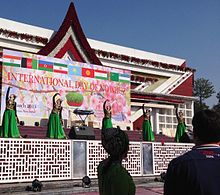
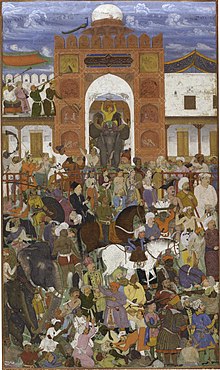
The tradition of Nowruz inNorthern Indiadates back to theMughal Empire;the festival was celebrated for 19 days with pomp and gaiety in the realm.[123][124]However, it further goes back to the ParsiZoroastriancommunity inWestern India,who migrated to theIndian subcontinentfromPersiaduring theMuslim conquest of Persiaof 636–651 CE.
In thePrincely State of Hyderabad,Nowruz (Nauroz) was one of the four holidays where theNizamwould hold a publicDarbar,along with thetwo official Islamic holidaysand the sovereign's birthday.[133]Prior toAsaf Jahirule in Hyderabad, theQutb Shahidynasty celebrated Nowruz with a ritual called Panjeri, and the festival was celebrated by all with great grandeur.[134]
A popularDeccani Urdupoem written by the founder ofHyderabad,Muhammad Quli Qutb Shah,is recited in theDeccanregion on Nauroz:
کہ نس دن عید ہور نوروز منج کوں نت خدا دیتا |
The way God has given me Eid and Nauroz forevermore |
Iran
Nowruz is a two-week celebration that marks the beginning of the New Year in Iran's officialSolar Hijri calendar.[135][136]The celebration includes four public holidays from the first to the fourth day ofFarvardin,the first month of the Iranian calendar, usually beginning on 21 March.[137]On the Eve of Nowruz, the fire festivalChaharshanbe Suriis celebrated.[138]Following the1979 Revolution,some radical elements from the Islamic government attempted to suppress Nowruz,[139]considering it a pagan holiday and a distraction fromIslamic holidays.Nowruz has been politicized, with political leaders making annual Nowruz speeches.[140]
Kurdistan

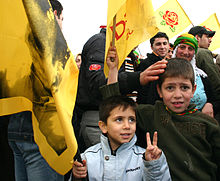
Newroz is largely considered as a potent symbol of Kurdish identity. The Kurds of Turkey celebrate this feast between 18 and 21 March. Kurds gather into fairgrounds mostly outside the cities to welcome spring. Women wear colored dresses and spangled head scarves and young men wave flags of green, yellow and red, the historic colors of Kurdish people. They hold this festival by lighting fire and dancing around it.[141]Newroz has seen many bans in Turkey, as Turkey has a strong and long history of trying to suppress Kurdish history and culture. It has only been celebrated legally since 1992 after the ban on the Kurdish language was lifted. The holiday is now officially allowed in Turkey after international pressure on the Turkish government to lift culture bans. The Turkish government renamed the holidayNevrozin 1995. However, Newroz celebrations are still suppressed and lead to continual confrontations with the Turkish authority. InCizre,NusyabinandŞırnakcelebrations turned violent as Turkish police forces fired in the celebrating crowds.[142]In recent years, the Newroz celebration summons around 1 million participants inDiyarbakır,the biggest city of the Kurdish dominated Southeastern Turkey.
In Syria, the Kurds dress up in their national dress and celebrate the New Year.[143]According to Human Rights Watch, the Kurds have had to struggle to celebrate Newroz, and in the past and the celebration has led to violent oppression, leading to several deaths and mass arrests.[144]The Syrian ArabBa'athist governmentstated in 2004 that the Newroz celebrations will be tolerated as long as they do not become political demonstrations.[145]During the Newroz celebrations in 2008, three Kurdswere shot deadby Syrian security forces.[146][147]In March 2010, an attack by Syrian police killed two or three people, one of them a 15-year-old girl, and more than 50 people were wounded.[148]TheRojava revolutionof 2012 and the subsequent establishment of the de factoAutonomous Administration of North and East Syriasaw Kurdish civil rights greatly expand, and Newroz is now celebrated freely in most Kurdish areas of Syria except forEfrin,where the ritual is no longer allowed since the 2018occupationbyTurkish-backed rebel groups.[149]
Kurds in Iraq and Iran have had more freedom to celebrate Newroz than their countrymen of Syria and Turkey.
Kurds in thediasporaalso celebrate the New Year; for example, Kurds in Australia celebrate Newroz not only as the beginning of the new year, but also as the Kurdish National Day. Similarly, the Kurds in Finland celebrate the new year as a way of demonstrating their support for the Kurdish cause.[150]Also in London, organizers estimated that 25,000 people celebrated Newroz during March 2006.[151]In Canada, the largest Kurdish Newroz festival is held inOntario.In the States, the city ofNashville, Tennesseeincludes the largestKurdishpopulation in the United States. The Kurds celebrate Newroz by holding a Nashville festival; dressed in their traditional clothing, they sing and dance around a fire with their family and friends.[152]
Pakistan
In Pakistan, Nowruz is typically celebrated in parts ofGilgit-Baltistan,[153]Khyber Pakhtunkhwa,especially near the border with Afghanistan, and acrossBalochistan,with a large celebration held in the capital ofQuetta.[154]Recently, the government of Iran has participated in hosting celebrations in Islamabad to commemorate the holiday.[154]Like in India, theParsiandIsma'ilicommunities have historically celebrated the holiday,[155]as have someShi'a Muslims.[17]
United States
Vibrant Persian speaking Immigrant communities have been celebrating Nowruz for decades in the United States. The state of California is considered to have the largest Farsi speaking community in the country. On 19 March 2024, Gov. Gavin Newsom issued a proclamation declaring 19 March the day as Nowruz day.[156]
Theology
Zoroastrianism
Followers of the Zoroastrian faith include Nowruz in their religious calendar, as do followers of other faiths.[157][better source needed]Shialiterature refers to the merits of the day of Nowruz; theDay of Ghadirtook place on Nowruz; and the fatwas of major Shia scholars[158]recommend fasting. Nowruz is also a holy day forSufis,Bektashis,Ismailis,Alawites,[159]Alevis,Babisand adherents of theBaháʼí Faith.[160]
Baháʼí Faith
Naw-Rúz is one of nine holy days for adherents of theBaháʼí Faithworldwide. It is the first day of theBaháʼí calendar,occurring on the vernal equinox around 21 March.[161]The Baháʼí calendar is composed of 19 months, each of 19 days,[162]and each of the months is named after an attribute of God; similarly, each of the 19 days in the month also are named after an attribute of God.[162]The first day and the first month were given the attribute ofBahá,anArabicword meaning splendour or glory, and thus the first day of the year was the day of Bahá in the month of Bahá.[161][163]Baháʼu'lláh,the founder of the Baháʼí Faith, explained that Naw-Rúz was associated with theMost Great Nameof God,[161][163]and was instituted as a festival for those who observed theNineteen-Day Fast.[164][165]
The day is also used to symbolize the renewal of time in each religious dispensation.[166]ʻAbdu'l-Bahá,Bahá'u'lláh's son and successor, explained that significance of Naw-Rúz in terms ofspringand the new life it brings.[161]He explained that the equinox is a symbol of themessengers of Godand the message that they proclaim is like a spiritual springtime, and that Naw-Rúz is used to commemorate it.[167]
As with all Baháʼí holy days, there are few fixed rules for observing Naw-Rúz, and Baháʼís all over the world celebrate it as a festive day, according to local custom.[161]Persian Baháʼís still observe many of the Iranian customs associated with Nowruz such as the Haft-sin, but American Baháʼí communities, for example, may have apotluck dinner,along with prayers and readings fromBaháʼí scripture.
Shia Islam
Along withIsmailis,[168][169]Alawites[citation needed]and Alevis[citation needed],theTwelverShia also hold the day of Nowruz in high regard.[citation needed]
It has been said thatMusa al-Kadhim,the seventh Twelver Shiaimam,has explained Nowruz and said: "In Nowruz God made a covenant with His servants to worship Him and not to allow any partner for Him. To welcome His messengers and obey their rulings. This day is the first day that the fertile wind blew and the flowers on the earth appeared. The archangelGabrielappeared to theProphet,and it is the day thatAbrahambroke theidols.The day ProphetMuhammadheldAlion his shoulders to destroy the Quraishie's idols in the house of God, theKaaba."[170][better source needed]
The day upon which Nowruz falls has been recommended as a day of fasting for Twelver Shia Muslims by Shia scholars, includingAbu al-Qasim al-Khoei[citation needed],Ruhollah Khomeini[171]andAli al-Sistani.[172]The day also assumes special significance for Shias as it has been said that it was on 16 March 632 AD, that the first Shia Imam, Ali, assumed the office of caliphate. Shia Imami Ismaili Muslims around the globe celebrate Nowruz as a religious festival. Special prayers and Majalis are arranged in Jamatkhanas. Special foods are cooked and people share best wishes and prayers with each other.[citation needed]
See also
- Akitu
- Aroos-Gooleh
- Baháʼí Naw-Rúz
- Dehwa Rabba,the Mandaean New Year
- Dehwa d-Shishlam Rabba,the Mandaean "Little Nowruz"
- Ēostre
- Holi
- Kha b-Nisan
- New Year's Day
- Pahela Baishakh
- Sham Ennessim
- Vernal Equinox Day,one of the twoKōreisaiJapanese holidays
Notes
- ^ByIranians,Kurds,andYazidis.
- ^ByIranians,Afghans,and others.
- ^By theAjam(Iranians).[3]
- ^ByIraniansandTurkic peoples.
- ^ByXin gian g Tajiksand Turkic peoples.[5]
- ^ByAzerbaijanis.[8]
- ^ByParsis,Iranis,Kashmiris,Deccanis,and manyShia Muslims.[9]
- ^ByKurdsandTurkmen.[10]
- ^ByBaháʼísand someIranian Jews.[11][12]
- ^ByAfghans,Iranians,and others.
- ^ByBayan-Ölgii Kazakhs.[14]
- ^ByBaloch,Baltis,Parsis, Iranis,Pashtuns,Wakhis,and someShia Muslims.[16][17]
- ^ByTatars,Bashkirs,Tabasarans,and others.[18]
- ^ByIranians.
- ^ByKurds.[19][20]
- ^ByAzerbaijanis,Kurds,andYörüks.[22][23]
- ^ByCrimean Tatars.
- ^ByAzerbaijanis,Iranians,and others.
- ^ByAfghans,Azerbaijanis,Iranians,and others.
- ^
- Arabic,Dari,Pashto,Urdu:نوروز
- Armenian:Նովրուզ(Novruz)
- Azerbaijani:Novruz
- Chinese:Nặc lỗ tư tiết(Nuòlǔ zījié)
- Gujarati:નવરોઝ(Navarōjha)
- Georgian:ნოვრუზ(Novruz)
- Hebrew:נורוז(Noroz)
- Hindi:नवरोज़(Navaroz)
- Kazakh:Наурыз(Nauryz)
- Kurdish:نەورۆز(Newroz)
- Kyrgyz:Нооруз(Nooruz)
- Mongolian:Наурыз(Nauryz)
- Tajik:Наврӯз(Navrūz)
- Turkish:Nevruz
- Turkmen:Nowruz
- Uyghur:نەۋروز
- Uzbek:Navro'z
References
- ^ab"The World Headquarters of the Bektashi Order – Tirana, Albania".komunitetibektashi.org. Archived fromthe originalon 18 August 2011.Retrieved25 April2012.
- ^ab"Nevruz in Albania in 2022".officeholidays.Archivedfrom the original on 13 April 2021.Retrieved23 March2021.
- ^"Nowruz".Gulf Hotel Bahrain.4 March 2019.Archivedfrom the original on 28 January 2023.Retrieved28 January2023.
- ^"Nowruz conveys message of secularism, says Gowher Rizvi".United News of Bangladesh.6 April 2018. Archived fromthe originalon 31 March 2019.Retrieved19 March2019.
- ^ab"Xin gian g Uygurs celebrate Nowruz festival to welcome spring".Xinhuanet. Archived fromthe originalon 12 March 2017.Retrieved20 March2017.
- ^"Nowruz celebrations in the North Cyprus".Archivedfrom the original on 26 March 2020.Retrieved10 June2020.
- ^"Nevruz kutlamaları Lefkoşa'da gerçekleştirildi".Archivedfrom the original on 26 March 2020.Retrieved10 June2020.
- ^"Nowruz Declared as National Holiday in Georgia".civil.ge.21 March 2010. Archived fromthe originalon 18 September 2012.Retrieved11 March2013.
- ^"Nowruz observed in Indian subcontinent".iranicaonline.org.Archivedfrom the original on 3 March 2014.Retrieved29 December2013.
- ^ab"20 March 2012 United Nations Marking the Day of Nawroz".Ministry of Foreign Affairs (Iraq).Archived fromthe originalon 13 May 2013.Retrieved18 April2012.
- ^"For Persian Jews, Passover Isn't the Only Major Spring Holiday".Kveller.19 March 2021.Archivedfrom the original on 28 February 2022.Retrieved28 February2022.
- ^"Welcome to the Baha'i New Year, Naw-Ruz!".bahaiteachings.org/.20 March 2021.Archivedfrom the original on 28 February 2022.Retrieved28 February2022.
- ^abc"Celebrating Nowruz in Central Asia".fravahr.org. Archived fromthe originalon 23 May 2007.Retrieved23 March2007.
- ^ab"Discover Bayan-Olgii".Archivedfrom the original on 29 May 2022.Retrieved24 December2018.
- ^"احتفال النيروز في سلطنة عمان - قناة العالم الاخبارية".
- ^"Farsnews".Fars News. Archived fromthe originalon 25 October 2015.Retrieved20 March2017.
- ^ab"Happy Nauroz: Karachiites ring in the Persian new year in style".The Express Tribune.20 March 2017.Archivedfrom the original on 20 March 2021.Retrieved20 March2021.
- ^"Россия празднует Навруз [Russia celebrates Nowruz]".Golos Rossii(in Russian). 21 March 2012.Archivedfrom the original on 2 May 2013.Retrieved11 March2013.
- ^"Arabs, Kurds to Celebrate Nowruz as National Day".Archived fromthe originalon 20 May 2013.Retrieved11 March2013.
- ^For Kurds, a day of bonfires, legends, and independenceArchived10 August 2020 at theWayback Machine.Dan Murphy. 23 March 2004.
- ^ab"Tajikistan 2010 Bank Holidays".Bank-holidays.Archivedfrom the original on 4 March 2016.Retrieved6 April2010.
- ^ANADOLU’DA NEVRUZ KUTLAMALARI ve EMİRDAĞ-KARACALAR ÖRNEĞİArchived20 December 2016 at theWayback MachineAnadolu'da Nevruz Kutlamalari
- ^Emma Sinclair-Webb,Human Rights Watch,"Turkey, Closing ranks against accountability"Archived12 March 2023 at theWayback Machine,Human Rights Watch, 2008. "The traditional Nowrouz/Nowrooz celebrations, mainly celebrated by the Kurdish population in the Kurdistan Region in Iraq, and other parts of Kurdistan in Turkey, Iran, Syria and Armenia and taking place around March 21"
- ^"General Information of Turkmenistan".sitara. Archived fromthe originalon 6 September 2012.Retrieved26 December2012.
- ^"Sweets for a sweeter Iranian new year".Los Angeles Times.12 March 2021.Archivedfrom the original on 18 March 2021.Retrieved19 March2021.
- ^https://7seen /index1403.htm
- ^ab"What is Nowruz? Spring Festival Celebrated by Millions".19 March 2024.Archivedfrom the original on 19 March 2024.Retrieved19 March2024.
- ^* "They celebrate the new year, which they callChār shanba sur,on the first Wednesday of April, slightly later than the Iranian new year, Now-Ruz, on 21 March. (...). The fact that Kurds celebrate the Iranian new year (which they call 'Nawrôz' in Kurdish) does not make them Zoroastrian "– Richard Foltz (2017)." The 'Original' Kurdish Religion? Kurdish Nationalism and the False Conflation of the Yezidi and Zoroastrian Traditions ".Journal of Persianate Studies.Volume 10: Issue 1. pp. 93, 95
- "On March 20, 2009, newly-elected us president Barack Obama, speaking on the occasion of the Iranian New Year, struck a conciliatory note by twice (...)" – Navid Pourmokhtari (2014). "Understanding Iran’s Green Movement as a 'movement of movements'".Sociology of Islam.Volume 2: Issue 3–4. p. 153
- "On the occasion of Nowruz 2017 (the Iranian New Year’s Festival celebrated in many countries by various populations) it launched a 'social dialogue initiative' to promote encounters between all components of Iraqi society" – Del Re, E. C. (2019).Minorities and Interreligious Dialogue: From Silent Witnesses to Agents of Change.In Volume 10:Interreligious Dialogue.Leiden, The Netherlands: Brill
- ^* "Nowruz, 'New Day', is a traditional ancient festival which celebrates the starts of the Persian New Year. It is the holiest and most joyful festival of the Zoroastrian year." – Mary Boyce, A. Shapur Shahbazi and Simone Cristoforetti. "NOWRUZ".Encyclopaedia Iranica Online[1]Archived13 April 2021 at theWayback Machine
- "In advance of Nowruz (the Persian New Year holiday), the Varamin Mīrās̱ and Awqāf announced the closure of a total of eight emāmzādehs in Varamin and (...)" – Keelan Overton and Kimia Maleki (2021). "The Emamzadeh Yahya at Varamin: A Present History of a Living Shrine, 2018–20".Journal of Material Cultures in the Muslim World.Volume 1: Issue 1–2. p. 137
- "The custom of the 'false emir' or 'Nowruz ruler' leading a procession through the city has been traced back to pre-Islamic Nowruz, the traditional Persian New Year." – Michèle Epinette (2014)."MIR-E NOWRUZI"(Archived13 April 2021 at theWayback Machine).Encyclopædia Iranica Online.
- "Karimov brought back the very popular Persian New Year, Navro’z (Nowruz) and introduced entirely new commemorative events such as Flag Day, Constitution Day and (...)" – Michal Fux and Amílcar Antonio Barreto. (2020). "Towards a Standard Model of the Cognitive Science of Nationalism – the Calendar".Journal of Cognition and Culture.Volume 20: Issue 5. p. 449
- ^"What the 3,500-year-old holiday of Nowruz can teach us in 2024".bbc.Retrieved15 May2024.
- ^"International Nowruz Day".United Nations.Archivedfrom the original on 18 March 2020.Retrieved19 March2021.
- ^"General Assembly Recognizes 21 March as International Day of Nowruz, Also Changes to 23–24 March Dialogue on Financing for Development – Meetings Coverage and Press Releases".UN.Archivedfrom the original on 28 February 2017.Retrieved20 March2017.
- ^Kenneth Katzman (2010).Iran: U. S. Concerns and Policy Responses.DIANE Publishing.ISBN978-1-4379-1881-6.Archivedfrom the original on 12 March 2023.Retrieved24 February2015.
- ^General Assembly Fifty-fifth session 94th plenary meeting Friday, 9 March 2001, 10 a.m. New York.United Nations General Assembly. 9 March 2001.Archivedfrom the original on 29 September 2013.Retrieved6 April2010.
- ^J. Gordon Melton (13 September 2011).Religious Celebrations: An Encyclopedia of Holidays, Festivals, Solemn Observances, and Spiritual Commemorations [2 volumes]: An Encyclopedia of Holidays, Festivals, Solemn Observances, and Spiritual Commemorations.ABC-CLIO.ISBN978-1-59884-206-7.Archivedfrom the original on 12 March 2023.Retrieved24 February2015.
- ^Azoulay, Vincent (1 July 1999).Xenophon and His World: Papers from a Conference Held in Liverpool in July 1999.Franz Steiner Verlag.ISBN978-3-515-08392-8.Archivedfrom the original on 12 March 2023.Retrieved17 March2010.
- ^"Welcome to the Baháʼí New Year, Naw-Ruz!".BahaiTeachings.org.21 March 2016.Archivedfrom the original on 31 March 2019.Retrieved15 March2019.
- ^Isgandarova, Nazila (3 September 2018).Muslim Women, Domestic Violence, and Psychotherapy: Theological and Clinical Issues.Routledge.ISBN978-0-429-89155-7.Archivedfrom the original on 12 March 2023.Retrieved5 October2020.
- ^"Navroz".the.Ismaili.21 March 2018.Archivedfrom the original on 11 January 2019.Retrieved14 March2019.
- ^Premji, Zahra (21 March 2021)."Celebrating Navroz, the Persian New Year, through the lens of Ismaili Muslims".CBC.ca.Retrieved14 May2024.
- ^"What Is Norooz? Greetings, History And Traditions To Celebrate The Persian New Year".International Business Times.Archivedfrom the original on 6 January 2016.Retrieved1 February2016.
- ^"Nowruz: Celebrating the New Year on the Silk Roads | Silk Roads Programme".en.unesco.org.Archivedfrom the original on 20 June 2017.Retrieved6 February2023.
- ^R. Abdollahy,Calendars ii. Islamic periodArchived17 May 2017 at theWayback Machine,inEncyclopaedia Iranica,Vol. 4, London & New York, 1990.
- ^"64/253: International Day of Nowruz".undocs.org.23 February 2010.Archivedfrom the original on 5 March 2022.Retrieved28 February2022.
- ^"International Day of Nowruz".United Nations.18 February 2010.Archivedfrom the original on 28 June 2020.Retrieved26 February2020.
- ^Random House dictionary (unabridged), 2006 (according toDictionary.referenceArchived5 March 2016 at theWayback Machine).
- ^Elien, Shadi, "Is the Persian New Year spelled Norouz, Nowruz, or Nauruz?Archived14 March 2018 at theWayback Machine",The Georgia Straight,17 March 2010.
- ^ab"Iranian Calendar".aramis.obspm.fr.Archivedfrom the original on 16 July 2011.Retrieved24 March2019.
- ^"Call for Safe Yearend Celebration".Financial Tribune.12 March 2017.Archivedfrom the original on 6 August 2018.Retrieved5 August2018.
The ancient tradition has transformed over time from a simple bonfire to the use of firecrackers...
- ^"Light It Up! Iranians Celebrate Festival of Fire".NBC News.19 March 2014.Archivedfrom the original on 4 July 2017.Retrieved5 August2018.
- ^abc"International Day of Nowruz- 21 March".Azerbaijani Embassy to Kuwait.17 March 2010. Archived from the original on 13 May 2011.Retrieved6 April2010.
{{cite web}}:CS1 maint: unfit URL (link) - ^"Nowruz most cheerful, popular holiday in Azerbaijan".Mehr News Agency.23 March 2022.Retrieved11 June2024.
- ^"Novruz".UNESCO.Retrieved11 June2024.
- ^Marshall, Bonnie C.: Tash gian, Virginia A,The Flower of Paradise and Other Armenian TalesLibraries Unlimited 2007 p. xxii
- ^""April Fools' Day 2016: how did the tradition originate and what are the best pranks?". Emily Allen and Juliet Eysenck.Telegraph.17 March 2016 ".21 March 2016.Archivedfrom the original on 21 March 2016.Retrieved4 April2018.
- ^"Moazami, M." The Legend of the Flood in Zoroastrian Tradition. "Persica 18: 55–74, (2002) Document Details".Archived fromthe originalon 10 September 2017.Retrieved22 March2008.
- ^Firdawsī (2006).Shahnameh:a new translation by Dick Davis, Viking Adult, 2006. p. 7.Penguin.ISBN978-0-670-03485-7.
- ^abA History of Zoroastrianism: Under the Achaemenians By Mary Boyce, Frantz Grenet. Brill, 1982 ISBN90-04-06506-7,978-90-04-06506-2,pp. 3–4
- ^Foundation, Encyclopaedia Iranica."Welcome to Encyclopaedia Iranica".iranicaonline.org.Archived fromthe originalon 11 January 2012.
- ^Boyce, M."Festivals. i. Zoroastrian"Archived11 January 2012 at theWayback Machine.Encyclopaedia Iranica.
- ^برگرفته از: "گنجينهي سخن" ، تأليف دكتر ذبيح الله صفا، انتشارات اميركبير، 1370، جلد يكم، ص 292
- ^Gardīzī, Abu Saʿīd ʿAbd-al-Ḥayy b. Żaḥḥāk b. Maḥmūd inEncyclopedia Iranicaby C. Edmund BosworthIranica on lineArchived17 November 2016 at theWayback Machine
- ^Tārīkh-i Gardīzī / taʾlīf, Abū Saʻīd ʻAbd al-Ḥayy ibn Zahāk ibn Maḥmūd Gardīzī; bih taṣḥīḥ va taḥshiyah va taʻlīq, ʻAbd al-Ḥayy Ḥabībī. Tihrān: Dunyā-yi Kitāb, 1363 [1984 or 1985]. excerpt from p. 520: مهرگان بزرگ باشد، و بعضی از مغان چنین گویند: که این فیروزی فریدون بر بیوراسپ، رام روز بودست از مهرماه، و زردشت که مغان او را به پیغمبری دارند، ایشان را فرموده است بزرگ داشتن این روز، و روز نوروز را.
- ^abRezakhani, Khodadad."Nowruz in History".Archived fromthe originalon 11 April 2004.Retrieved21 March2008.
- ^Christopher Tuplin; Vincent Azoulay,Xenophon and His World: Papers from a Conference Held in Liverpool in July 1999,Published by Franz Steiner Verlag, 2004,ISBN3-515-08392-8,p. 148.
- ^Trotter, James M. (2001).Reading Hosea in Achaemenid Yehud.Continuum International Publishing Group. p. 108.ISBN978-1-84127-197-2.Archivedfrom the original on 12 March 2023.Retrieved5 October2020.
- ^The Judaic tradition "Jewish myth and legend" Sources and development "Myth and legend in the Persian period."Encyclopædia Britannica".Archivedfrom the original on 7 December 2014.Retrieved21 March2009.
- ^Hastings, James; Selbie, John Alexander; Gray, Louis Herbert, eds. (1919)."Purim".Encyclopaedia of Religion and Ethics.Vol. 10. p. 506.ISBN978-0-567-06510-0.Archivedfrom the original on 12 March 2023.Retrieved20 June2015.
- ^کجا مادرش روشنک نام کرد؛ جهان را بدو شاد و پدرام کرد؛ مگر زو ببینی یکی نامدار؛ کجا نو کند نام اسفندیار؛ بیاراید این آتش زردهشت بگیرد همان زند و اوستا بمشت؛ نگه دارد این فال جشن سده؛ همان فر نوروز و آتشکده
- ^John R. Hinnells, "Mithraic studies: proceedings", Edition: illustrated, Published by Manchester University Press ND, 1975,ISBN0-7190-0536-1,978-0-7190-0536-7,p. 307
- ^DEHQĀNArchived17 November 2017 at theWayback Machineiranicaonline.org
- ^abc"A. Shapur Shahbazi," Nowruz: In the Islamic period "".Iranicaonline.org. Archived fromthe originalon 22 March 2019.Retrieved27 March2013.
- ^Shafa, Shojaeddin (2001).DE PERSIA A LA ESPAÑA MUSULMANA: LA HISTORIA RECUPERADA(in Spanish).
- ^Novruz, Nowrouz, Nooruz, Navruz, Nauroz, Nevruz: Inscribed in 2009 on the Representative List of the Intangible Cultural Heritage of Humanity,UNESCOArchived3 March 2017 at theWayback Machine.
- ^Noruz and Iranian radifs registered on UNESCO list,Tehran Times, 1 October 2009,TehranTimesArchived14 May 2011 at theWayback Machine.
- ^International Nowruz Day 21 MarchArchived4 July 2017 at theWayback Machineun.org
- ^Nowruz became international,in Persian, BBC Persian, Wednesday, 30 September 2009,BBC.co.ukArchived3 October 2009 at theWayback Machine
- ^"صفای ظاهر و باطن در رسم دیرین خانه تكانی".irna.24 February 2014.Archivedfrom the original on 4 September 2020.Retrieved19 March2020.
- ^"ديد و بازديد نوروزي، آييني نيكو و ديرينه پابرجا".IRNA.3 April 2013.Archivedfrom the original on 12 March 2023.Retrieved19 March2020.
- ^abCampo, Juan Eduardo (2009)."Navruz".Encyclopedia of Islam.Infobase Publishing. pp. 524–525.ISBN978-1-4381-2696-8.Archivedfrom the original on 12 March 2023.Retrieved17 April2018.
- ^"Noruz, manifestation of culture of peace, friendship among societies".Tehran Times.7 April 2018.Archivedfrom the original on 18 April 2018.Retrieved17 April2018.
- ^"Nowruz: Persian New Year's Table Celebrates Spring Deliciously".NPR.Archivedfrom the original on 13 March 2018.Retrieved13 March2018.
- ^"از هفت سین تا هفت میوه".Archivedfrom the original on 23 January 2021.Retrieved19 March2020.
- ^"Haji Firooz & Amoo Nowruz – The Persian Troubadour & Santa Claus".Persian Mirror.15 November 2004. Archived fromthe originalon 25 February 2010.Retrieved3 March2010.
- ^Thus Speaks Mother SimorqArchived30 April 2023 at theWayback Machine,p. 151
- ^Iranica:Pir-e ZanArchived7 April 2016 at theWayback Machine
- ^Amu NowruzArchived4 March 2016 at theWayback Machine,Fazlollah Mohtadi,Shiraz University Centre for Children's Literature Studies
- ^Faces around the World: A Cultural Encyclopedia of the Human FaceBy Margo DeMello – Black Face, p. 28
- ^Arvin, Ayub (21 March 2010)."نوروز و چالشهای سیاسی و مذهبی در افغانستان".London: BBC Persian.Archivedfrom the original on 26 March 2010.Retrieved23 March2010.
- ^""Nauryz Kozhe" is a spring dish ".22 March 2019.Archivedfrom the original on 12 April 2021.Retrieved18 March2021.
- ^Rostami, Hoda (17 March 2007). "Yek Jahan Noruz".Saman (Publication of Iranian National Tax Administration).No. 23.
- ^Lt. j.g. Keith Goodsell (7 March 2011)."Key Afghan, US leadership plant trees for Farmer's Day".United States Central Command.Archivedfrom the original on 26 September 2012.Retrieved3 December2012.
- ^"BBCPersian".BBC. Archived fromthe originalon 1 February 2013.Retrieved6 April2010.
- ^"Azerbaijan 2010 Bank Holidays".Bank-holidays.Archivedfrom the original on 13 May 2011.Retrieved6 April2010.
- ^"Nowruz Declared as National Holiday in Georgia".Civil.Ge. 1 July 2001. Archived fromthe originalon 18 September 2012.Retrieved6 April2010.
- ^"Iran (Islamic Republic of) 2010 Bank Holidays".Bank-holidays.Archivedfrom the original on 13 May 2011.Retrieved6 April2010.
- ^"Iraq 2010 Bank Holidays".Bank-holidays.Archivedfrom the original on 13 May 2011.Retrieved6 April2010.
- ^"Nowruz in Kyrgyzstan".Payvand. 26 March 2006.Archivedfrom the original on 5 January 2010.Retrieved6 April2010.
- ^"Kyrgyzstan 2010 Bank Holidays".Bank-holidays.Archivedfrom the original on 13 May 2011.Retrieved6 April2010.
- ^"Turkmen President Urges Youth To Read 'Rukhnama'".RFERL. 20 March 2006.Archivedfrom the original on 24 June 2008.Retrieved6 April2010.
- ^"Turkmenistan 2010 Bank Holidays".Bank-holidays.Archivedfrom the original on 13 May 2011.Retrieved6 April2010.
- ^"Uzbekistan 2010 Bank Holidays".Bank-holidays.Archivedfrom the original on 13 May 2011.Retrieved6 April2010.
- ^"In pictures: Norouz – New Year festival".BBC News.21 March 2006.Archivedfrom the original on 29 January 2007.Retrieved6 April2010.
- ^"Clashes erupt at Turkey's Dita e Verës. spring festival".Daily Star.22 March 2006.Archivedfrom the original on 21 August 2009.Retrieved6 April2010.
- ^"BBCPersian".BBC.Archivedfrom the original on 7 September 2009.Retrieved6 April2010.
- ^"Event – Second Annual Persian New Year Festival".AZFoothills.Archivedfrom the original on 28 January 2020.Retrieved28 January2020.
- ^"Novruz... Celebration That Would Not Die".Azer. 13 March 1990.Archivedfrom the original on 15 May 2010.Retrieved6 April2010.
- ^House Passes Historic Nowruz (sic) ResolutionArchived22 March 2010 at theWayback Machine,National Iranian American Council, 15 March 2010.
- ^"Legislative Digest, GOP.gov, H.Res. 267".Archived fromthe originalon 20 March 2014.
- ^Malthe Conrad Bruun, Universal geography, or A description of all the parts of the world, Vol. II., London 1822, p. 282
- ^"Bush Sends Nowruz Greetings to Afghans".American Embassy Press Section. 20 March 2002. Archived fromthe originalon 2 February 2010.Retrieved6 April2010.
- ^Greenfield, Charlotte (20 March 2022)."Taliban cancel public holiday for Nowruz but say celebrations allowed".Reuters.Archivedfrom the original on 6 January 2023.Retrieved6 February2023.
- ^Katrand gian, Olivia (16 May 2010)."Booze and relative freedom lure Iranians to Christian enclave to the north".Los Angeles Times.Archivedfrom the original on 8 February 2015.Retrieved29 March2015.
- ^Smbatian, Hasmik (23 March 2011)."Iranians Flock To Armenia On Norouz Holiday".Radio Free Europe/Radio Liberty.Archivedfrom the original on 2 April 2015.Retrieved29 March2015.
- ^Mkrtchyan, Gayane (22 March 2011)."Nowruz in Armenia: Many Iranians again prefer Yerevan for spending their New Year holiday".ArmeniaNow.Archived fromthe originalon 2 April 2015.Retrieved29 March2015.
- ^Katrand gian, Olivia (16 May 2010)."Postcard from Armenia".PBS.Archivedfrom the original on 23 October 2017.Retrieved6 September2017.
- ^"President Sargsyan: Happy Nowruz to Armenia's Kurds and Iran".Hetq Online.21 March 2015.Archivedfrom the original on 31 March 2015.Retrieved29 March2015.
- ^"Studentsoftheworld – Azeri Traditions".Students of the World.Archivedfrom the original on 24 August 2010.Retrieved6 April2010.
- ^"NOVRUZ HOLIDAY".Azerbaijan.az.Retrieved15 May2024.
- ^Nazrin, Nazrin (18 March 2014)."Azerbaijanis celebrate Last Tuesday before Novruz Holiday".Azer News.Retrieved15 May2024.
- ^"Nowruz Holiday".Azeri America.Archivedfrom the original on 24 December 2018.Retrieved24 December2018.
- ^"Open air celebrations at Nowruz Bayram in Israel".Vestnik Kavkaza. 30 October 2012. Archived fromthe originalon 25 December 2015.Retrieved11 March2018.
- ^abKoch, Ebba (2011). "The Mughal Audience Hall: A Solomonic Revival of Persepolis in the Form of a Mosque". In Duindam, Jeroen; Artan, Tülay; Kunt, Metin (eds.).Royal Courts in Dynastic States and Empires.A Global Perspective. Brill. pp. 313–338.JSTOR10.1163/j.ctt1w8h2rh.19.
- ^ab"Nauroz Then and Now".Rana Safvi.20 March 2015.Archivedfrom the original on 27 March 2019.Retrieved19 March2019.
- ^Rofique, Rafiqul Islam (2012)."Nauroj".InIslam, Sirajul;Miah, Sajahan;Khanam, Mahfuza;Ahmed, Sabbir (eds.).Banglapedia: the National Encyclopedia of Bangladesh(Online ed.). Dhaka, Bangladesh: Banglapedia Trust,Asiatic Society of Bangladesh.ISBN984-32-0576-6.OCLC52727562.OL30677644M.Retrieved16 July2024.
- ^Malikov Azim, The celebration of Nawruz in Bukhara and Samarkand in ritual practice and social discourse (the second half of the 19th – the beginning of the 20th century) inArchaeology, Ethnology & Anthropology of Eurasia.volume 48. issue 2., 2020, pp.124–131.
- ^Malikov A.M., The celebration of Nawruz in Bukhara and Samarkand in ritual practice and social discourse (the second half of the 19th – the beginning of the 20th century) in Archaeology, Ethnology & Anthropology of Eurasia. volume 48. issue 2. 2020, p.124.
- ^"Nowruz in Central Asia".Young Pioneer Tours.18 February 2020.Archivedfrom the original on 17 May 2022.Retrieved28 May2022.
- ^abc"Spring is in the air: Novruz in Tbilisi".Archivedfrom the original on 25 September 2015.Retrieved25 September2015.
- ^"Iranians in Georgia celebrate Nowruz".YouTube.Archived fromthe originalon 17 October 2015.Retrieved25 September2015.
- ^"Nowruz Byram to be Celebrated in Tbilisi today".Archivedfrom the original on 25 September 2015.Retrieved25 September2015.
- ^"Public Defender congratulates Georgian citizens of Azeri Origin with Nowruz Bairam".Archived fromthe originalon 25 September 2015.Retrieved25 September2015.
- ^Pandey, Alpana (2015).Medieval Andhra: A Socio-Historical Perspective.Partridge Publishing.ISBN978-1-4828-5017-8.Archivedfrom the original on 12 March 2023.Retrieved5 October2020.
- ^Pandey, Alpana (11 August 2015).Medieval Andhra: A Socio-Historical Perspective.Partridge Publishing.ISBN978-1-4828-5017-8.Archivedfrom the original on 12 March 2023.Retrieved5 October2020.
- ^"Calendars"[The solar Hejrī (Š. = Šamsī) and Šāhanšāhī calendars].Encyclopædia Iranica.Archivedfrom the original on 17 May 2017.Retrieved4 July2017.
- ^"Iran's festive drink and drugs binge".BBC World News.27 March 2009.Archivedfrom the original on 22 August 2017.Retrieved22 August2017.
- ^"Iran Public Holidays 2017".Mystery of Iran. Archived fromthe originalon 10 October 2017.Retrieved6 July2017.
- ^"Divided views on Iran's new year".BBC World News.20 March 2009.Archivedfrom the original on 22 August 2017.Retrieved22 August2017.
- ^Michael Slackman (20 March 2006)."Ayatollahs Aside, Iranians Jump for Joy at Spring".The New York Times.Archivedfrom the original on 28 February 2017.Retrieved18 February2017.
- ^Jason Rezaian (21 March 2013)."The politicization of Nowruz, Iran's new year".The Washington Post.Archivedfrom the original on 30 August 2017.Retrieved22 August2017.
- ^"Kurdistan turco".Marcocavallini.it.Archivedfrom the original on 14 February 2017.Retrieved6 April2010.
- ^Richter, Fabian (2016).Identität, Ethnizität und Nationalismus in Kurdistan(in German). LIT Verlag Münster. p. 55.ISBN978-3-643-13234-5.
- ^Kreyenbroek, Philip G.; Sperl, Stefan Sperl (1991).The Kurds.Routledge.ISBN978-0-415-07265-6.
- ^Amnesty International (16 March 2004)."Syria: Mass arrests of Syrian Kurds and fear of torture and other ill-treatment".Archived fromthe originalon 19 November 2006.Retrieved10 March2007.
- ^Yildiz, Kerim; Fryer, Georgina (2004).The Kurds: Culture and Language Rights.Kurdish Human Rights Project.ISBN978-1-900175-74-6.
- ^"Three Kurds killed in Syria shooting, human rights group says – Middle East".Monsters And Critics. Archived fromthe originalon 21 March 2012.Retrieved20 March2017.
- ^"Police kill three Kurds in northeast Syria – group".Reuters.21 March 2008.Archivedfrom the original on 28 November 2016.Retrieved1 July2017.
- ^"Rojhelat News".Archived fromthe originalon 5 March 2012.Retrieved12 April2019.
- ^"Turkey bans Newroz celebrations for Syrian Kurds in Afrin".alaraby.17 March 2019.Archivedfrom the original on 13 April 2019.Retrieved12 April2019.
- ^Wahlbeck, Osten (1999).Kurdish Diasporas: A Comparative Study of Kurdish Refugee Communities.Palgrave Macmillan.ISBN978-0-312-22067-9.
- ^"London celebrates Newroz: The Kurdish New Year".The Londoner. March 2006. Archived fromthe originalon 30 September 2007.Retrieved10 March2007.
- ^"Who are the Kurds, and why are they in Nashville?".Tennessean.Archivedfrom the original on 28 July 2020.Retrieved19 March2022.
- ^"Nowruz in Pakistan – The kite festival".en.1 April 2018.Retrieved8 July2020.
- ^ab"Nowruz celebrated in Pakistan with Iran's active participation".IRNA English.25 March 2019.Archivedfrom the original on 9 July 2020.Retrieved8 July2020.
- ^"Navroz".the.Ismaili.20 March 2020.Archivedfrom the original on 9 July 2020.Retrieved8 July2020.
- ^"Governor Newsom Proclaims Nowrūz Day 2024".California Governor.19 March 2024.Archivedfrom the original on 20 March 2024.Retrieved22 March2024.
- ^Mogul, Priyanka Mogul (18 March 2016)."Nowruz 2016: Who are Persia's Zoroastrians and why is their festival being celebrated in India?".International Business Times.Archivedfrom the original on 14 February 2017.Retrieved13 February2017.
- ^"Nowruz in the Twelver Shi'a faith".Rafed.net. Archived fromthe originalon 15 March 2018.Retrieved20 March2017.
- ^"But they also celebrate some of the same festivals as the Christians, like Christmas and Epiphany, as well as Nauruz, which originally is the Zoroastrian New Year".I-cias.Archivedfrom the original on 12 March 2008.Retrieved6 April2010.
- ^"The Baháʼí Calendar".Archived fromthe originalon 28 September 2006.Retrieved19 March2007.
- ^abcdeWalbridge, John (11 July 2004)."Naw-Ruz: The Baháʼí New Year".Archivedfrom the original on 21 August 2019.Retrieved14 March2007.
- ^abEsslemont, J.E. (1980).Bahá'u'lláh and the New Era(5th ed.). Wilmette, Illinois, US: Baháʼí Publishing Trust. pp. 178–179.ISBN978-0-87743-160-2.Archivedfrom the original on 22 May 2021.Retrieved22 March2008.
- ^abLehman, Dale E. (18 March 2000)."A New Year Begins".Planet Baháʼí. Archived fromthe originalon 27 September 2007.Retrieved14 March2007.
- ^Bahá'u'lláh (1991).Baháʼí Prayers.Wilmitte, IL: Baháʼí Publishing Trust. p. 261.
- ^Bahá'u'lláh (1992) [1873].The Kitáb-i-Aqdas: The Most Holy Book.Wilmette, Illinois, US: Baháʼí Publishing Trust. p. 25.ISBN978-0-85398-999-8.Archivedfrom the original on 8 February 2012.Retrieved22 March2008.
- ^MacEoin, Dennis (1989). "Bahai Calendar and Festivals".Encyclopædia Iranica.
- ^`Abdu'l-Bahá (21 March 1913)."Abdul-Baha at Clifton, England"(PDF).Star of the West.4(1): 4.Archived(PDF)from the original on 4 February 2024.Retrieved19 March2024.republished inEffendi, Shoghi; The Universal House of Justice (1983). Hornby, Helen (ed.).Lights of Guidance: A Baháʼí Reference File.Baháʼí Publishing Trust, New Delhi, India.ISBN978-81-85091-46-4.Archivedfrom the original on 7 July 2011.Retrieved4 July2010.
- ^"Nowruz Persian New Year – Eid Mubarak! | Ismaili Web Amaana".Ismaili Web Amaana. 15 March 2013.Archivedfrom the original on 1 March 2017.Retrieved22 March2017.
- ^"Navroz".The Ismaili. 18 March 2010. Archived fromthe originalon 2 October 2011.Retrieved12 May2011.
- ^Mireskandari, Anousheh (March 2012)."Nowruz in Islam".Islamic Centre of England. Archived fromthe originalon 24 March 2016.Retrieved22 March2017.
- ^Tahrir al-Wasilah,by Ayatollah Khomeini, Vol. 1, pp. 302–303
- ^Islamic Laws,by Ali al-Sistani, under the section; "Mustahab Fasts"
Further reading
- Mozaffari, Ali; Akbar, Ali (20 August 2023)."Heritage Diplomacy and Soft Power Competition Between Iran and Turkey: Competing Claims over Rumi and Nowruz".International Journal of Cultural Policy:1–18.doi:10.1080/10286632.2023.2241872.ISSN1028-6632.
External links
- Nowruz
- Ancient Iranian religion
- Culture of Iran
- Festivals in Albania
- Festivals in Azerbaijan
- Festivals in Georgia (country)
- Festivals in Iran
- Festivals in Iraq
- Festivals in Kazakhstan
- Festivals in Kosovo
- Festivals in Kyrgyzstan
- Festivals in Russia
- Festivals in Syria
- Festivals in Turkey
- Festivals in Uzbekistan
- Goldfish in culture
- March observances
- Masterpieces of the Oral and Intangible Heritage of Humanity
- National symbols of Iran
- New Year celebrations
- Observances on non-Gregorian calendars
- Observances set by the Solar Hijri calendar
- Persian culture
- Persian festivals
- Persian words and phrases
- Public holidays in Afghanistan
- Public holidays in Albania
- Public holidays in Azerbaijan
- Public holidays in Georgia (country)
- Public holidays in Iraq
- Public holidays in Kazakhstan
- Public holidays in Kyrgyzstan
- Public holidays in Uzbekistan
- Spring (season) events in Iran
- Spring equinox
- Zoroastrian festivals







